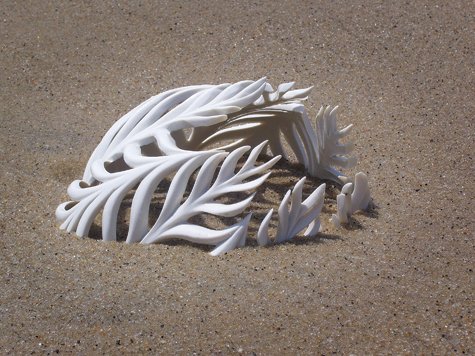ARTIST PROFILE

The Porcelain Sorceress
Jennifer McCurdy Carves Her Own Path
Profile by Karla Araujo
Most people on the Island probably know me as ‘that bicycle lady,’” Jennifer McCurdy says, a smile in her voice. “They don’t even know about my work.” But it is her work that stops people as they meander up Main Street in Vineyard Haven past the window of the Shaw Cramer Gallery. For the past 17 years, her elegant white porcelain vessels have risen as if by magic both in the window and from their pedestals in the second floor gallery above. And, as if the decorative translucent pieces weren’t astonishing enough in their simple beauty, Jennifer has recently married the ancient art of gilding with her 30-year passion for unglazed porcelain. Her newest work glows with an other-worldly light, adding even greater drama to the swirling decorative forms.
“But back to that bicycle lady,” as Jennifer refers to herself. She is a familiar sight, pedaling purposefully along a 20- mile route from her home in Vineyard Haven through Oak Bluffs, to Edgartown along Sengekontacket Pond, then returning on an interior path each morning year-round when her 100-minute constitutional is complete.
ride every day, even in the rain,” she explains. “The only time I don’t ride is if it’s too icy. If I miss the ride I have too much nervous energy. I love seeing the light and use the ride to comb my mind every morning.”
“Combing her mind” may not be a familiar concept to most, but then neither are the fractals Jennifer says inspire her sculptural works. “I’m fascinated by fractals,” she admits. Then, as if realizing that fractals are not in many of our everyday vocabularies, she adds that they relate to an instinctual feeling of comfort we achieve if a space or a density of pattern feels right. “I’m not good at explaining what they are,” she says, “but it’s important that the patterns I see around me are integrated into my forms.” Fractals, according to the simplest definition, are geometric shapes that have symmetry of scale. According to Jennifer, it is this balance that she both responds to in nature and seeks to impart in her pottery.
Fractals aside, Jennifer’s work stands alone in the difficult world of wheel-thrown porcelain. It is a fascinating study in contrasts, her lacy and intricately carved pieces that manage to appear extremely fragile, yet attain a durability that she says “could last 10,000 years.”
Jennifer starts the process by air-drying her clay in an arch to stiffen it. She then kneads or “wedges” the porcelain 100 strokes to prepare it for the potter’s wheel. Throwing on the wheel, she quickly pulls the clay up into a traditional cylindrical shape. Next, using an Asian technique called “dry throwing” (due to the absence of water), she coaxes the cylinder into a sphere. When she’s satisfied with the shape of the piece, she removes it from the wheel, then alters it with her fingers, pushing and folding the clay. Once it becomes what she calls “leather-hard,” and feels “like chilled butter,” she uses tools to cut, trim and scrape the material, carving patterns to create what she refers to as “energy and counterpoint.” She must work surely, rapidly and accurately, spending about 45 minutes carving a small piece. If she takes too long, the piece will dry and crack. After firing it twice in her kiln, the second time at a whopping 2,350 degrees Fahrenheit, the piece vitrifies, or becomes nonporous and rock-hard.
“People always ask me how long it takes to create one of my pieces,” Jennifer says. “I tell them about eight hours and 30 years.” Her point: the learning curve in her work is steep. She has had to become extremely proficient in throwing on the wheel before she could even contemplate altering the form to the degree she desires. Each piece is instinctual, building on the work that preceded it. “It’s moving, changing, growing finer and more open, but under control at all times,” she explains. In contrast, she says, people who understand porcelain ask, “How on earth could you possibly do the carving in the narrow window of time you have to work in?” It is the difficulty of her craft that makes Jennifer’s work stand alone in her field. “By the time artists develop my skill set, they would want their own voice,” she says. “And no one else is crazy enough to do this!”
Jennifer shows her work in galleries, museum shops and at high- end juried craft shows across the country, traveling either on her own or with her husband Tom McCurdy, whom she characterizes as her one-man support system. Tom, owner of Vineyard Haven’s McCurdy Motorcars, has long helped Jennifer make travel arrangements, drive to shows, set up her booth, deal with customers, and translate technical “computerese” into manageable administrative tasks. Recently, however, their partnership evolved even further with Jennifer’s move into gilded porcelain.
Although she feels that she still has much to learn about pushing the limits of her medium, Jennifer says that she had been intrigued with the idea of adding gold leaf to some of her pieces. Now, thanks to a collector’s creative idea, she has.
In 2009, art collectors Bill and Paula Mitchell of St. Mary’s City, Maryland, approached Jennifer with a proposal. They already owned several of her vessels and wanted to acquire more. But Bill expressed his concern that many artists seem constrained by the pressure to create work that will sell, rather than trying to create great art. His proposal: they would send Jennifer a monthly stipend in exchange for her development of a completely unique new work.
The rules were simple: The Mitchells would provide little or no guidance to Jennifer about their aesthetic; they would agree with her on a price, after which they would make an initial down payment, followed by regular monthly payments; and the Mitchells had to accept the finished piece. According to Bill, he had already commissioned work from three other artists under similar terms and all parties had emerged satisfied with both the arrangement and the results.
“It’s good for the artist and for the collector,” he explains. “It allows the artist the freedom to experiment in a new direction, to take risks, and it allows the collector to pay for a work of value over time.”
Jennifer entered into an agreement with the Mitchells, which Bill followed up with a confirmation letter and the first monthly check. The commission, Jennifer says, was just the encouragement she needed to explore creating a pair of “nesting” vessels – a 7”x10”x10” outer vessel, along with a 7”x7”x7” that fit perfectly inside. In addition to the challenge of perfecting the fit between the two lacy pieces, Jennifer decided to experiment with applying gold leaf on the interior surface of the outside vessel to see how it would reflect on the exterior of the smaller vessel.
“Porcelain and gold each has its own reflective quality,” Jennifer says. “I was interested in the interaction of the two.”
She knew that applying gold leaf requires, as she puts it, “a skill set unto itself.” Serendipitously, Tom had acquired precisely those skills in his previous career as a sign painter. He agreed to show his wife how to gild her porcelain, but, she says, they soon agreed that he was far more adept at the task. Today, Tom and Jennifer gild about one-third of her pieces, a collaborative process that she says she enjoys despite its painstaking nature.
The decision to add a metallic sheen to her work didn’t come easily, however. While porcelain and gold leaf have been combined by artisans for centuries, Jennifer was fighting against the modern potters’ widely held view that it is, she says, “a travesty to do anything to a piece after it’s fired.” Bucking against recent tradition and her own concerns that she might be “gilding the lily,” Jennifer reports enthusiastic reaction to her work not only by the Mitchells but by other collectors as well. Bill says that the one-of- a-kind gilded nesting set glows on a shelf in his home, picking up even the faintest light, even moonlight. A collector of paintings and sculptural wood, he now says that he and Paula are committed to becoming “deep collectors” of Jennifer’s ongoing work.
Jennifer’s one-of-a-kind pieces are included in the permanent collections of such prestigious museums as the Smithsonian’s Renwick Gallery in Washington, DC, the Columbia Museum of Art in Columbia, SC, and the Everson Museum of Art in Syracuse, NY. This summer, Nancy Shaw Cramer plans to show Jennifer’s latest work in a one-week show opening on July 13. “People are astounded by the perfection of her carving,” Nancy says. “Most people say they’ve never seen anything like it.”
Outwardly modest about her accomplishments, Jennifer says that she feels very fortunate to live on a beautiful Island surrounded by a supportive artist community. Her hope, she says, is that people will feel uplifted as a result of her work. “When people tell me they still love a piece of mine they bought 15 years ago that’s a wonderful compliment. I know it’s grown on them and has taken on a spiritual worth. We should all give ourselves the solace of art,” she concludes.
Jennifer McCurdy’s work is represented by the Shaw Cramer Gallery at 76 Main Street, Vineyard Haven or visit www.jennifermccurdy.com.
“But back to that bicycle lady,” as Jennifer refers to herself. She is a familiar sight, pedaling purposefully along a 20- mile route from her home in Vineyard Haven through Oak Bluffs, to Edgartown along Sengekontacket Pond, then returning on an interior path each morning year-round when her 100-minute constitutional is complete.
ride every day, even in the rain,” she explains. “The only time I don’t ride is if it’s too icy. If I miss the ride I have too much nervous energy. I love seeing the light and use the ride to comb my mind every morning.”
“Combing her mind” may not be a familiar concept to most, but then neither are the fractals Jennifer says inspire her sculptural works. “I’m fascinated by fractals,” she admits. Then, as if realizing that fractals are not in many of our everyday vocabularies, she adds that they relate to an instinctual feeling of comfort we achieve if a space or a density of pattern feels right. “I’m not good at explaining what they are,” she says, “but it’s important that the patterns I see around me are integrated into my forms.” Fractals, according to the simplest definition, are geometric shapes that have symmetry of scale. According to Jennifer, it is this balance that she both responds to in nature and seeks to impart in her pottery.
Fractals aside, Jennifer’s work stands alone in the difficult world of wheel-thrown porcelain. It is a fascinating study in contrasts, her lacy and intricately carved pieces that manage to appear extremely fragile, yet attain a durability that she says “could last 10,000 years.”
Jennifer starts the process by air-drying her clay in an arch to stiffen it. She then kneads or “wedges” the porcelain 100 strokes to prepare it for the potter’s wheel. Throwing on the wheel, she quickly pulls the clay up into a traditional cylindrical shape. Next, using an Asian technique called “dry throwing” (due to the absence of water), she coaxes the cylinder into a sphere. When she’s satisfied with the shape of the piece, she removes it from the wheel, then alters it with her fingers, pushing and folding the clay. Once it becomes what she calls “leather-hard,” and feels “like chilled butter,” she uses tools to cut, trim and scrape the material, carving patterns to create what she refers to as “energy and counterpoint.” She must work surely, rapidly and accurately, spending about 45 minutes carving a small piece. If she takes too long, the piece will dry and crack. After firing it twice in her kiln, the second time at a whopping 2,350 degrees Fahrenheit, the piece vitrifies, or becomes nonporous and rock-hard.
“People always ask me how long it takes to create one of my pieces,” Jennifer says. “I tell them about eight hours and 30 years.” Her point: the learning curve in her work is steep. She has had to become extremely proficient in throwing on the wheel before she could even contemplate altering the form to the degree she desires. Each piece is instinctual, building on the work that preceded it. “It’s moving, changing, growing finer and more open, but under control at all times,” she explains. In contrast, she says, people who understand porcelain ask, “How on earth could you possibly do the carving in the narrow window of time you have to work in?” It is the difficulty of her craft that makes Jennifer’s work stand alone in her field. “By the time artists develop my skill set, they would want their own voice,” she says. “And no one else is crazy enough to do this!”
Jennifer shows her work in galleries, museum shops and at high- end juried craft shows across the country, traveling either on her own or with her husband Tom McCurdy, whom she characterizes as her one-man support system. Tom, owner of Vineyard Haven’s McCurdy Motorcars, has long helped Jennifer make travel arrangements, drive to shows, set up her booth, deal with customers, and translate technical “computerese” into manageable administrative tasks. Recently, however, their partnership evolved even further with Jennifer’s move into gilded porcelain.
Although she feels that she still has much to learn about pushing the limits of her medium, Jennifer says that she had been intrigued with the idea of adding gold leaf to some of her pieces. Now, thanks to a collector’s creative idea, she has.
In 2009, art collectors Bill and Paula Mitchell of St. Mary’s City, Maryland, approached Jennifer with a proposal. They already owned several of her vessels and wanted to acquire more. But Bill expressed his concern that many artists seem constrained by the pressure to create work that will sell, rather than trying to create great art. His proposal: they would send Jennifer a monthly stipend in exchange for her development of a completely unique new work.
The rules were simple: The Mitchells would provide little or no guidance to Jennifer about their aesthetic; they would agree with her on a price, after which they would make an initial down payment, followed by regular monthly payments; and the Mitchells had to accept the finished piece. According to Bill, he had already commissioned work from three other artists under similar terms and all parties had emerged satisfied with both the arrangement and the results.
“It’s good for the artist and for the collector,” he explains. “It allows the artist the freedom to experiment in a new direction, to take risks, and it allows the collector to pay for a work of value over time.”
Jennifer entered into an agreement with the Mitchells, which Bill followed up with a confirmation letter and the first monthly check. The commission, Jennifer says, was just the encouragement she needed to explore creating a pair of “nesting” vessels – a 7”x10”x10” outer vessel, along with a 7”x7”x7” that fit perfectly inside. In addition to the challenge of perfecting the fit between the two lacy pieces, Jennifer decided to experiment with applying gold leaf on the interior surface of the outside vessel to see how it would reflect on the exterior of the smaller vessel.
“Porcelain and gold each has its own reflective quality,” Jennifer says. “I was interested in the interaction of the two.”
She knew that applying gold leaf requires, as she puts it, “a skill set unto itself.” Serendipitously, Tom had acquired precisely those skills in his previous career as a sign painter. He agreed to show his wife how to gild her porcelain, but, she says, they soon agreed that he was far more adept at the task. Today, Tom and Jennifer gild about one-third of her pieces, a collaborative process that she says she enjoys despite its painstaking nature.
The decision to add a metallic sheen to her work didn’t come easily, however. While porcelain and gold leaf have been combined by artisans for centuries, Jennifer was fighting against the modern potters’ widely held view that it is, she says, “a travesty to do anything to a piece after it’s fired.” Bucking against recent tradition and her own concerns that she might be “gilding the lily,” Jennifer reports enthusiastic reaction to her work not only by the Mitchells but by other collectors as well. Bill says that the one-of- a-kind gilded nesting set glows on a shelf in his home, picking up even the faintest light, even moonlight. A collector of paintings and sculptural wood, he now says that he and Paula are committed to becoming “deep collectors” of Jennifer’s ongoing work.
Jennifer’s one-of-a-kind pieces are included in the permanent collections of such prestigious museums as the Smithsonian’s Renwick Gallery in Washington, DC, the Columbia Museum of Art in Columbia, SC, and the Everson Museum of Art in Syracuse, NY. This summer, Nancy Shaw Cramer plans to show Jennifer’s latest work in a one-week show opening on July 13. “People are astounded by the perfection of her carving,” Nancy says. “Most people say they’ve never seen anything like it.”
Outwardly modest about her accomplishments, Jennifer says that she feels very fortunate to live on a beautiful Island surrounded by a supportive artist community. Her hope, she says, is that people will feel uplifted as a result of her work. “When people tell me they still love a piece of mine they bought 15 years ago that’s a wonderful compliment. I know it’s grown on them and has taken on a spiritual worth. We should all give ourselves the solace of art,” she concludes.
Jennifer McCurdy’s work is represented by the Shaw Cramer Gallery at 76 Main Street, Vineyard Haven or visit www.jennifermccurdy.com.









